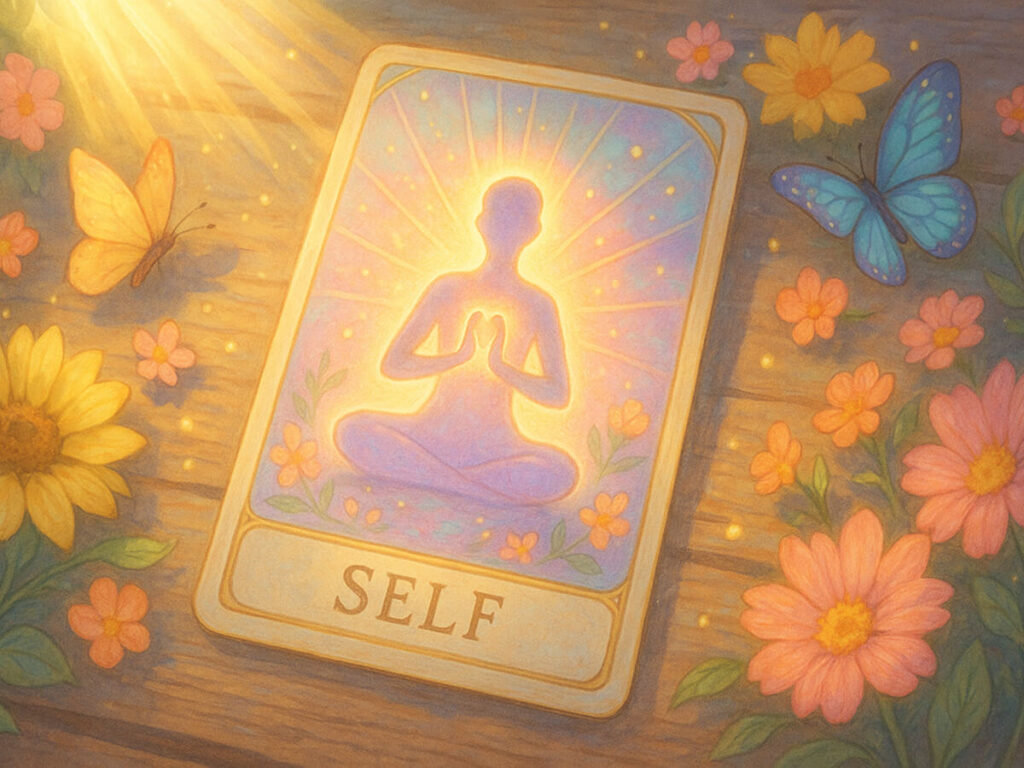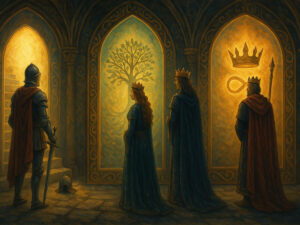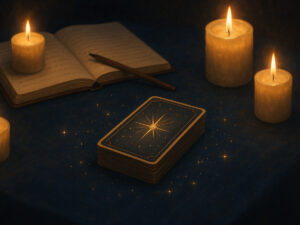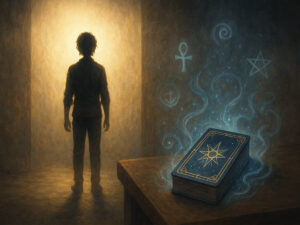A Tarot Self Discovery Guide for 2025


Table of Contents
Hello there, kindred spirits. Miranda Starr here. It warms my heart to connect with you today about something truly special, something that’s been a guiding light in my own life for, goodness, over forty years now – the Tarot. Now, I know what some of you might be thinking. Fortune telling? Crystal balls? While the Tarot certainly has a mystical air, and goodness knows I’ve seen my share of uncanny insights over the decades, its real power, the magic I’ve witnessed transform lives, lies much deeper. Think of it less like a prediction machine and more like… a mirror. A beautifully intricate mirror reflecting the hidden corners of your own soul.
Did you know that studies, like one I read recently in a journal exploring consciousness studies, suggest that regular self-reflection practices can increase self- awareness by up to 40%? That’s quite something, isn’t it? And Tarot, my dears, is one of the most profound introspection tools I’ve ever encountered. It’s not about rigidly telling you what will happen, but about illuminating the why behind your feelings, the patterns you might be stuck in, and the incredible potential waiting within you.
It’s about tarot for understanding self, a tarot journey unique to each person. Over my years, traveling, studying, and guiding thousands – yes, thousands! – from my little corner here tracing soulmate connections to helping folks navigate life’s twists, I’ve seen Tarot act as a key. A key to unlock doors within ourselves we didn’t even know existed.
This guide, this little chat we’re having, is my offering to you. We’ll explore how you can use these cards, these whispers of tarot symbolism and tarot archetypes, not just for fleeting answers, but for genuine personal growth tarot, lasting tarot insight, and a deeper, more compassionate understanding of the most important person in your life: You. So, grab a cup of tea, settle in, and let’s begin this wonderful path of tarot for self discovery together.
What is Tarot for Self Discovery?
Okay, so we’ve settled in. Let’s chat about what this whole tarot for self discovery thing really is. It’s a term you hear floating around, but sometimes it gets mixed up with the idea of predicting lottery numbers or knowing exactly when you’ll meet Prince Charming. Now, don’t get me wrong, the cards can offer incredible tarot guidance and sometimes hint at possibilities down the road.
I’ve certainly seen it happen! But using tarot for understanding self is a different kettle of fish entirely. It’s less about gazing into the future and more about deeply understanding the present. Your present.
Right here, right now. Think of it as a conversation with your deeper self, the part of you that often gets drowned out by the hustle and bustle of daily life. You know, that quiet inner voice? Tarot helps amplify it.
It’s a powerful introspection tool, a way to explore your own inner world exploration. We use the cards, their rich tarot symbolism and ancient tarot archetypes, to uncover those subconscious tarot patterns, the beliefs you might not even realize you hold, and the motivations driving your choices. It’s about fostering genuine growth using personal development tools from within.
I remember years ago, when I was first really diving deep into my studies in Europe – oh, the places I saw! – I kept pulling the Three of Swords. Over and over. At first, I was a bit put out, thinking, “Oh dear, heartbreak again?”
But sitting with it, really feeling into it through the lens of self-discovery, I realized it wasn’t about a future event. It was reflecting a past sorrow I hadn’t fully processed, a little shard still lodged in my heart affecting how I connected with people then. That was a huge moment of tarot clarity for me.
It wasn’t predicting pain; it was revealing where healing was needed. See the difference? It’s subtle, but profound. It’s a common misconception, really, that tarot is only about fortune telling; many experienced readers, as noted in various esoteric journals, emphasize its psychological and reflective applications.
The benefits? Oh, my goodness. Where to begin? Gaining tarot clarity on confusing situations is a big one.
Sometimes we feel stuck, don’t we? Like we’re walking in fog. Tarot can act like a gentle breeze, clearing the mist just enough to see the next step.
It’s fantastic for uncovering those hidden beliefs tarot whispers about – the “I’m not good enoughs” or “I can’t do thats” that hold us back without us even knowing. And conversely, it’s brilliant for identifying your strengths! Sometimes we forget how capable we are. The cards can remind you of your resilience, your creativity, your unique gifts.
It helps you explore potential paths, not by saying “Go left!”, but by showing you what the journey left might feel like, what resources you’d draw upon, what challenges might arise. It empowers you to choose, offering tarot insight rather than rigid directives. This focus on the internal landscape is what truly distinguishes it from purely predictive readings.
And just a little tarot history snippet, because I find it fascinating, and understanding origins helps ground the practice, I think. These cards weren’t always mystical tools. Way back, centuries ago in Italy, they started as playing cards for games!
Can you imagine? It was only later, perhaps in the 18th century according to historical consensus, as people recognized the depth of the imagery, that they evolved into the guidance cards we know today, used for meditation, reflection, and yes, tarot and spirituality. It’s a beautiful evolution, I think.
From simple games to profound psyche exploration. It shows how meaning can deepen over time, much like our own self-understanding does when we commit to the tarot journey. It’s not about magic spells; it’s about focused attention and honest reflection, using these beautiful cards as our guide.
It’s a practice, a way of connecting, and it’s available to anyone willing to look within. It’s about building self-awareness tarot style.
Getting Started on Your Journey
Now, embarking on this tarot journey might feel a tad intimidating at first. All those cards! All that symbolism! I remember feeling a flutter of nerves myself, way back when.
But trust me, dear heart, getting started is simpler than you might think. It’s not about becoming an expert overnight; it’s about taking that first curious step towards tarot for understanding self.
First things first: your deck. Choosing tarot deck is quite personal, I feel. Some people are drawn to the classic Rider-Waite-Smith deck, the one you often see with its iconic imagery – it’s a wonderful foundation, truly.
Others might prefer the intricate symbolism of the Thoth deck, or perhaps one of the thousands of beautiful modern decks available today, each with its unique artistic style. What matters most, I believe, is finding a deck that speaks to you. Does the artwork resonate?
Do the colours make you feel something? I recall helping a young woman once, completely overwhelmed by choice. We simply sat quietly, looking through several decks, until her eyes lit up at one depicting nature scenes.
“This one feels like home,” she whispered. That’s the connection you’re looking for! Don’t overthink it. Let your intuition guide you when connecting with tarot cards visually.
Your first deck doesn’t have to be your forever deck, either. Mine certainly wasn’t! It was a rather simple, slightly worn hand-me-down, but it taught me so much.
Once you have your cards, it’s nice to, well, introduce yourself! Connecting with tarot cards energetically is important. Some people like to cleanse their new deck – perhaps passing it through sage smoke (if you like that sort of thing), or simply shuffling them thoroughly while focusing on your intention to use them for self-reflection tarot.
I sometimes just hold a new deck close for a while, or even sleep with it under my pillow for a night or two. Sounds a bit silly, maybe, but it’s about creating a bond, infusing the cards with your energy and purpose. It’s less about rigid rules and more about what feels right and respectful to you and your new introspection tool.
Creating a little space for your readings can also be helpful. It doesn’t need to be fancy! A quiet corner, a clean tabletop, maybe a candle if that helps you focus.
The main thing is minimizing distractions so you can tune into your thoughts and the cards’ messages. Think of it as setting the stage for a quiet conversation with yourself. A calm environment really does aid tarot clarity, I find.
And speaking of clarity, let’s talk about questions. The way you ask is quite important in tarot for self discovery. Instead of asking yes/no questions like “Will I get the job?”, try framing them more openly, focusing on insight.
For example: “What can I learn from this job opportunity?” or “What strengths can I bring to this situation?” or “What underlying patterns might be affecting my career path?” See how that opens things up? It invites tarot insight and tarot guidance, rather than demanding a simple prediction.
It puts the focus back on your internal landscape and personal growth tarot opportunities. Finally, and this is something I perhaps didn’t take seriously enough when I first started – tarot journaling! Oh, please do keep a journal.
Write down the date, your question, the cards you pulled, and your initial thoughts or feelings about them. Don’t worry about getting the “right” interpretation immediately. Just jot down what comes up.
Then, revisit your entries later – maybe a week, maybe a month. It’s absolutely fascinating to see how your understanding deepens or how situations evolved. I made the mistake early on of thinking I’d just remember my readings.
Ha! Life gets busy, doesn’t it? Those early insights faded. Journaling creates a tangible record of your tarot journey, helps you spot recurring themes or cards (hello, Three of Swords!), and truly builds that self-awareness tarot promotes.
It turns fleeting moments of tarot insight into lasting lessons. It’s probably one of the most practical personal development tools in this whole process. So, find a notebook you like, and make it your Tarot companion!
Powerful Tarot Spreads for Insight
Alright, now for some real fun! Once you’re feeling a bit more comfortable with your cards, you can start exploring different layouts, or spreads. Think of tarot spreads for self as frameworks for your questions, ways to arrange the cards to tell a specific kind of story about your inner world.
There are countless spreads out there, truly, but I want to share a few that I’ve found particularly powerful for tarot insight and self-reflection tarot over the years. Remember that website I looked at earlier, Lyn Thurman’s site? It had some lovely examples that align well with what I’ve used myself.
Different spreads simply help focus the tarot guidance you receive. One I often recommend for a good internal check-in is the Self-Reflection Spread. It’s like taking an honest look in that mirror I mentioned.
You typically use five cards. The first shows your present self tarot – how you are right now. The second reveals the ‘Mask’ – the face you show the world, which isn’t always the same, is it?
The third, oh, this one’s juicy – the ‘Shadow’. It points to those subconscious tarot bits, maybe tarot for fears or things you haven’t quite acknowledged (shadow work tarot). The fourth card highlights the main ‘Lesson’ you’re currently learning – life is always teaching us, after all!
And the fifth offers guidance on the ‘Path Forward’. I once did this spread for a gentleman who seemed very confident, all businesslike (his Mask was The Emperor, naturally!), but his Shadow card was the Five of Cups, showing deep, unacknowledged grief. It opened up a space for him to explore that hidden sadness, which was subtly impacting his present life.
It’s a potent spread for self-awareness tarot. Then there’s the Life Purpose Spread. This one’s a bit bigger, often seven cards, and it delves into your deeper calling.
It looks at your core self discovery, your passions, your natural talents (discover talents tarot), significant life lessons tarot learned, challenges you might face (overcoming challenges tarot), the support systems around you, and finally, practical next steps. It’s less about predicting one specific job and more about understanding the themes and energies that make you feel fulfilled.
It’s a wonderful spread for those moments when you feel a bit adrift, seeking direction or confirmation on your life path tarot. It really helps unlock potential tarot insights. For a more holistic view, I sometimes use a Chakra Tarot Spread.
This connects the cards to the seven main energy centers in the body, from the Root (security, grounding) up to the Crown (spirituality, connection). You draw a card for each chakra. It can give you a fascinating snapshot of your energetic state – where energy might be flowing freely (perhaps an Ace of Cups on the Sacral chakra, suggesting emotional openness) or where there might be blockages (maybe a Four of Pentacles on the Root, indicating a fear of lack).
It’s a beautiful way to check in on your overall well-being, connecting mind, body, and spirit, promoting emotional balance tarot and highlighting areas needing self-care tarot. And because our relationships are such fertile ground for growth, the Mirror Spread is invaluable.
It usually uses six cards to explore the dynamic between you and another person. One card for you, one for them, one for the relationship’s strengths, one for its weaknesses or challenges, one for hidden influences (those undercurrents!), and one for the path forward together or individually.
It’s not about blaming, mind you, but about understanding the interplay, offering tarot for relationships clarity and improving tarot communication insights. Of course, you don’t always need complex spreads! A simple three card spread (like Past-Present- Future, or Situation-Action-Outcome) can offer wonderful tarot guidance for a specific question.
And never underestimate the power of a daily tarot draw! Just pulling one card in the morning and reflecting on its energy throughout your day is a fantastic way to build your tarot intuition development and make mindful tarot practice a habit. It keeps you connected to your introspection tool and the ongoing conversation with yourself.
The key is finding what resonates with you and serves your tarot journey of personal transformation tarot.
Interpreting Cards Through the Lens of Self
So, you’ve chosen your deck, maybe tried a spread or two… now what? How do you actually understand what the cards are trying to tell you? This is where the real heart of tarot for self discovery lies – in the art of interpretation.
Now, most decks come with a little white book (LWB, we often call them) giving basic tarot keywords and tarot card meanings. These are useful starting points, absolutely! But please, please don’t treat them like rigid dictionaries.
True tarot insight comes from blending those traditional meanings with your own intuition, your own life experience. It’s about interpreting tarot cards with your heart as much as your head. I remember when I was learning, I pulled the Ten of Swords for myself.
Oh, the drama! The LWB said things like “rock bottom,” “ruin,” “betrayal.” I spent the whole day feeling anxious, waiting for disaster! Later that evening, reflecting more deeply, I realized it wasn’t about some impending doom.
I was simply exhausted. Mentally drained from overworking. The card, in my context, was dramatically showing the end of my energy cycle, urging me to rest.
Sticking only to the book meaning caused unnecessary worry! That taught me a valuable lesson about tarot intuition development. The LWB gives you the alphabet, but you form the words and sentences that make sense for your story.
Look closely at the imagery. What catches your eye? What feelings does the card evoke in you? Forget the official meaning for a moment.
Does that figure in the Eight of Cups look sad to be leaving, or determined? Does the landscape in the Four of Wands feel celebratory to you, or maybe a bit overwhelming? Connecting the tarot symbolism to your personal life is key.
If you pull The Lovers, yes, it can mean partnership, but maybe for you, right now, it speaks to a crucial choice you need to make, aligning your actions with your values. That personal connection is where the tarot guidance becomes truly tailored, truly meaningful. It’s a core part of tarot for understanding self.
Pay attention to patterns, too. Do certain cards seem to stalk you? Does the Queen of Swords keep appearing every time you think about speaking up at work?
Maybe she’s nudging you to embrace your intellectual clarity and direct communication! Recurring cards or suits often highlight ongoing themes or lessons your subconscious wants you to address. Your tarot journaling will be invaluable here for spotting these patterns over time, enhancing your self-awareness tarot practice.
And let’s talk about those cards that make people gulp – The Tower, Death, The Devil. Scary, right? Well, not necessarily! In tarot for self discovery, these powerful cards often signify major breakthroughs, necessary endings, or confrontations with our own shadow aspects (shadow work tarot).
The Tower isn’t always a catastrophe; it can be a sudden realization that shatters a false belief. Death rarely means physical death; it usually points to transformation, shedding old skin to allow for new growth – a crucial part of personal transformation tarot. The Devil can highlight feelings of bondage or addiction, yes, but seeing it is the first step to breaking free!
Understanding the lessons within these challenging cards is vital. They often carry the most potent messages for growth. Think of the Major Arcana meanings especially – those 22 trump cards from The Fool to The World – as representing significant life lessons, universal experiences, or Jungian archetypes tarot playing out within you.
The Empress might be your nurturing side, The Hermit your need for introspection, Strength your inner resilience. Relating these powerful figures to parts of yourself adds incredible depth to your interpreting tarot cards practice. It’s a rich, layered process, this tarot journey, and your unique perspective is the most important ingredient.
Trust it.
Integrating Tarot Wisdom into Daily Life
Discovering insights through tarot for self discovery is wonderful, truly illuminating. But the real magic happens when we take those insights off the table and weave them into the fabric of our everyday lives. What good is tarot clarity if it doesn’t lead to change, even small shifts?
It’s about moving from understanding to action, or sometimes, simply to a new way of being. This integration is where the personal growth tarot promises really blossom. It doesn’t always mean making huge, dramatic changes, mind you.
Sometimes, the wisdom gained from a reading is subtle. Perhaps you pulled the Four of Swords, suggesting rest. Integrating that might simply mean consciously deciding to take a quiet evening for yourself instead of pushing through exhaustion – a small act of self-care tarot inspired guidance.
Or maybe the Queen of Cups appeared, reminding you of compassion. Integrating that could mean approaching a difficult conversation with more empathy than you might have otherwise. It’s about letting the tarot guidance gently nudge your choices and perspectives.
I often suggest to people I read for, and it’s a sentiment echoed by many experienced practitioners I’ve spoken with over the years, to pick just one small action or mindset shift inspired by a reading and focus on that. Trying to overhaul everything at once can be overwhelming! Tarot can also become a wonderful ally in mindful decision-making.
When faced with a choice, instead of asking “What should I do?”, you can use the cards to explore the potential energies or outcomes of different paths. For instance, pulling cards for Option A might bring up themes of stability and slow growth (perhaps Pentacles), while Option B might show cards suggesting rapid change and challenges (maybe Wands and Swords).
This doesn’t mean Option A is definitively “better,” but it gives you more information, more tarot insight into the nature of each choice. It helps you make decisions that feel more aligned with your core self discovery journey, rather than just reacting impulsively. It’s like having a wise friend offering different perspectives before you commit.
One of the most significant long-term benefits I’ve seen, both in myself and others, is how a regular mindful tarot practice builds self-awareness tarot style. When you consistently check in with yourself using the cards, you start recognizing your own patterns much more quickly. Maybe you notice that the Five of Wands (conflict, competition) often appears when you’re dealing with a particular family member.
That awareness allows you to approach those interactions differently, perhaps more consciously choosing collaboration over conflict. Or you might see the Knight of Cups popping up whenever you start a new creative project, reminding you of your initial passion and idealism. Recognizing these triggers and tendencies, highlighted by your introspection tool, is incredibly empowering.
It’s like turning the lights on in rooms you used to stumble around in. But consistency really is key here. Like any relationship, your connection with your cards and your deeper self deepens with regular attention.
Making tarot for self discovery a regular practice – whether it’s a daily tarot draw, a weekly spread, or simply pulling cards when you feel stuck or reflective – keeps the conversation flowing. It’s not about dependency; it’s about maintaining an open channel for tarot insight and spiritual guidance. Think of it like tending a garden; occasional watering helps, but consistent care yields the most beautiful blooms.
This ongoing tarot journey helps integrate the wisdom naturally, making personal transformation tarot less of a dramatic event and more of a steady, unfolding process. It becomes part of how you navigate your world, with a little more understanding, a little more grace. And isn’t that a lovely way to live?
Your Journey Unfolds
Well now, we’ve covered quite a bit of ground together, haven’t we? From understanding that tarot for self discovery is more about inner exploration than fortune-telling, to choosing a deck, trying out spreads like the Self-Reflection Spread or the Life Purpose Spread, and learning to trust your own tarot intuition development when interpreting tarot cards. We’ve talked about how this isn’t just about gaining tarot insight, but about weaving that wisdom into your daily life, fostering real personal growth tarot style.
My deepest hope is that you feel a little less intimidated and a lot more curious about using Tarot as your personal introspection tool. It truly is a dynamic, compassionate companion for the tarot journey of tarot for understanding self. Remember that chance encounter I had all those years ago?
It sparked a lifelong passion, not just for the cards, but for the incredible capacity we all have for self-awareness tarot helps unlock. As I always say, “The deepest truths aren’t shouted from mountaintops; they’re whispered in the quiet spaces within.” Tarot helps create those quiet spaces.
Don’t strive for perfection, especially if you’re just starting out (tarot for beginners is a journey!). Be patient with yourself. Be open. Be curious. Embrace the process with an open heart.
Your path of self-reflection tarot is uniquely yours, and every step, every card pulled, is part of your unfolding story. Perhaps start with a simple daily tarot draw, or explore one of the tarot spreads for self we discussed when you feel called to. The most important thing is to begin.
Frequently Asked Questions
I often get asked a few common questions when folks are starting their tarot journey, so I thought I’d address them here!
Can a complete beginner use tarot for self-discovery?
Absolutely, my dear! In many ways, beginners have an advantage – fewer preconceived notions! Tarot for beginners focused on self-discovery is wonderful. Start simple, be patient, use your journal, and focus on how the cards make you feel. It’s your personal development tools journey.
Do I need special psychic abilities to read tarot for myself?
Not at all! While intuition definitely grows with practice (tarot intuition development is real!), using tarot for self discovery relies more on honesty, reflection, and your willingness to connect with the tarot symbolism. Everyone has intuition; Tarot just helps you tune into it.
How often should I perform self-discovery readings?
There’s no single right answer. Some find a daily tarot draw helpful. Others prefer a weekly check-in or only pull cards when facing a specific question or feeling stuck. Listen to yourself. The goal is mindful tarot practice, not rigid obligation. Consistency helps, but don’t force it.
What if I pull a ‘scary’ or negative card?
Take a deep breath! As we discussed, cards like The Tower, Death, or The Devil often carry important messages about necessary change, endings, or confronting hidden beliefs tarot might reveal. In self-reflection tarot, they aren’t curses. Ask yourself: What might need to end? What truth needs to be faced? What structure needs to crumble for something new to be built? They often signify areas ripe for personal transformation tarot.
Is there a ‘right’ way to interpret the cards for self-discovery?
The ‘right’ way is the way that resonates truthfully with you. While understanding traditional tarot card meanings and tarot archetypes provides a foundation, your personal experiences and intuition are crucial. Use the LWB as a guide, not a rulebook. The most powerful tarot insight often comes from that personal connection.






